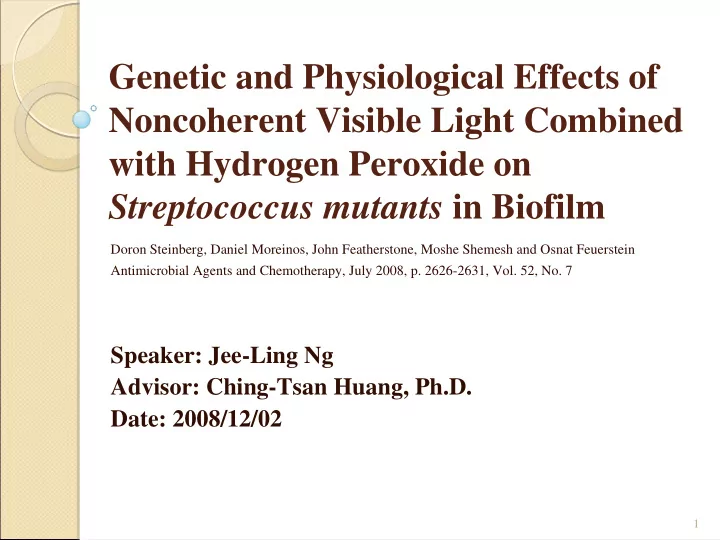

Genetic and Physiological Effects of Noncoherent Visible Light Combined with Hydrogen Peroxide on Streptococcus mutants in Biofilm Doron Steinberg, Daniel Moreinos, John Featherstone, Moshe Shemesh and Osnat Feuerstein Antimicrobial Agents and Chemotherapy, July 2008, p. 2626-2631, Vol. 52, No. 7 Speaker: Jee-Ling Ng Advisor: Ching-Tsan Huang, Ph.D. Date: 2008/12/02 1
What are biofilms? Biofilm in pipe section Biofilm in acidic pools at Dental plaque Yellowstone National Park. 2
Biofilm formation Planktonic bacteria extracellular polymeric substances or (EPS) 3 Resource: The Center for Biofilm Engineering at Montana State University-Bozeman
Characteristic of biofilms � Dynamic � Genetic expression is different in biofilm 4 � Less sensitive to antimicrobial agents
How do biofilms impact our w orld? 5 Resource: The Center for Biofilm Engineering at Montana State University-Bozeman
Dental plaque Bacterial Biofilm TOOTH The Center for Biofilm Engineering at Montana State University-Bozeman DECAY Gingivitis Periodontal Caries 6 disease
Streptococcus mutants � Gram-positive, facultative anaerobic bacteria � Utilize sucrose to produce polysaccharide � Relies on biofilm lifestyle 7
Antimicrobial Methods Photodynamic action Antibiotics Chemical Chemical photosensitizer photosensitizer Visible light / UV Higher energy Higher energy Resistance! excited states excited states Reactive Reactive Free Free oxygen species oxygen species radicals radicals (ROS) (ROS) 8
Pros and Cons of light irradiation for biofilm treatment � Pros - Capable to penetrate the deeper layers of biofilm than any chemical agents. - No bacteria resistant to light irradiation - Can be targeted very precisely - Intensity of the irradiation can be monitored. � Cons - Can only treat areas where light can reach 9
Mechanism of Visible Light Phototoxicity on Porphyromonas gingivalis and Fusobacterium nucleatum Photochemistry and Photobiology, 2005, 81: 1186–1189 These results support the assumption that the phototoxic effect of blue light on the periopathogenic bacteria is oxygen dependent and that hydroxyl radicals play an important role in this process. Blue light Planktonic H 2 O 2 10
Aim of this study Aim of this study Streptococcus mutants Noncoherent blue light + H 2 O 2 Gene expression Bacterial viability 11
Bacterial Viability � Microbial assays � Confocal Scanning Laser Microscopy (CSLM) � ATP analysis 12
Bacterial biofilm growth after exposure to 13 O 2 blue light in combination with H 2 Synergistic effect 2.3 log 1.5 log
Bacterial biofilm growth versus planktonic bacteria growth after blue light and 30 mM H 2 O 2 treatment Time exposure Bacterial biofilm Planktonic bacteria More effective against bacterial biofilm 30 s 2.12 log 0.72 log than against planktonic bacteria 60 s 2.6 log 1.19 log 14
Phototoxic effect of blue light and H 2 O 2 H 2 O 2 O 2 � Fe 3+ + . OH + OH - Fe 2+ + H 2 Fenton reaction Hydroxyl radical Oxidative stress cell damage 15
CSLM Images of different layers in biofilm (a) Immediately after exposure - No effect on bacterial viability through all layers of the biofilm (b) 3 hours after exposure - Significant bacteria death in the middle layers (35~65 μ m) of the biofilm (c) 6 hours after exposure - Most of the bacteria death through all layers of the biofilm Live/dead BacLight bacterial viability kit Green: Live bacteria Green: Live bacteria 16 Red : Dead bacteria Red : Dead bacteria Yellow : Both live and dead Yellow : Both live and dead bacteria bacteria
CSLM image of biofilm 3 hours after light exposure for 60 seconds Top of biofilm Deepest layer of biofilm Significant bacteria death in the 17 middle layers (35~65 μ m) of the biofilm
CSLM image of biofilm 6 hours after light exposure for 60 seconds Top of biofilm Deepest layer of biofilm Most of the bacteria death through 18 all layers of the biofilm
The combination of light and H 2 O 2 has an advantage in penetrating the deep layers of the biofilm Surface O 2 molecules H 2 � H 2 O 2 are small compare with Middle layer the photosensitizers molecules � The disruption of the biofilm by photo-oxidation may enhance Deep layer the penetration into the biofilm 19
ATP levels of bacteria in biofilm light exposure for 60 seconds and 30 mM H 2 O 2 Significant effect on bacterial metabolic activity in biofilm 20
Why bacterial ATP levels sharply increase after light and H 2 O 2 treatment ? � Accumulation of ROS in the biofilm creates environmental conditions stressful to the exposed bacteria � In response, bacteria in biofilm enhance ATP production to adapt the stressful environment 21
Several genes association with biofilm formation of S. mutants � gtfB (GTFB, glucan production) - Play a pivotal role in sucrose-dependent bacterial adhesion � brpA (Biofilm-regulating protein) � smu630 (Biofilm formation hypothetical protein) � comDE (Competence-stimulating peptide) - Histidine kinase receptor ( com D ) - Response regulator ( com E ) � relA (Guanosine tetra (penta)-phosphate synthetase) � ftf (FTF, fructan production) 22
Relative expression of several genes related to biofilm formation 24 hours after treatment X8 X6 X4 X5 23
24 Conclusion Synergistic effect
CFU counts CSLM Image Check Check ATP Level Gene Expression S. mutants 25
THANK YOU FOR YOUR ATTENTION ! Special Gratitude to Prof. Huang 26
Photosensitizers (PS) � Characteristics -Absorb light -Cause photochemical reaction � More than 400 compounds are PS - Dyes, drugs and natural substances - Examples: Natural Substances Dyes Flavins Methylene blue Chlorophyll Toluidine blue O Polyacetylenes Phthalocyanines 27
Hydrogen peroxide � Low cost � Generally recognized as safe as an antimicrobial agent 28
Recommend
More recommend